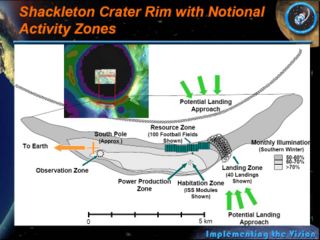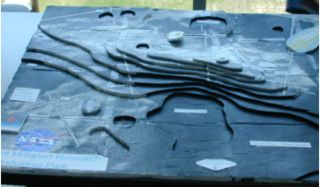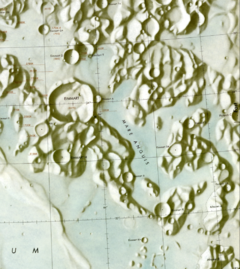Site Selection
This article is a topic of debate. |
Contents
Lunar Settlement Site Selection
And, the Great Instant Science Head Butting
A great contest is shaping up over the selection for the first, and quite likely only at least for a long time, site for a settlement on the Moon.
Currently available data is not adequate to definitively pick the winning location. Soon, enough new data will be available from missions like LRO to nail down the choice.
Right now, somebody should organize a contest between the different parties supporting specific sites. Maybe that somebody should be Lunarpedia.
Important Activity Zones for Site Selections
A good lunar settlement site must have a number of areas for specific activities. In designing a space settlement, these areas are called activity zones. Each of these activity zones will have very demanding requirements. A good settlement site will rate high in a number of activity zones, but need not be at the top of every one.
Good travel routes and communications lines will be needed connecting each of the zones to alow people, robots, and information to travel freely. Some of the most important activity zones include:
- Surface Habitation Zone
- This zone for buildings needs to be fairly flat and smooth. It should be away from other sites that represent dangers, like the Landing Zone, and away from activities that will seriously kick up dust, like the industrial zones. For some sites, such as scientific instrument locations, this zone will be of only short term importance as there will be no permanent habitation.
- Landing and Launch Zone
- This zone needs to be flat and smooth. You cannot land a spacecraft in a field of boulders. We nearly lost one or two Apollo missions to this problem. This zone must also be separated from other zones by some distance (one kilometer has been suggested). It must have good access to stable lunar orbits with workable emergency landing areas along probable emergency orbit paths. This is a difficult requirement to meet in the lunar polar regions.
- Earth Communication Zone
- This zone must have an unrestricted view of the Earth at all times for microwave antennas and laser communications telescopes. Even a glancing path near the lunar horizon could be a problem. This zone covers most of the lunar hemisphere facing the Earth.
- There is a thin libration zone near the lunar limb where the Earth will dip above and below the horizon, or where local terrain could obstruct the line of sight. In these areas there may be peaks with good Earth views close to valleys with good Earth shielding. Such a site would be idea for a number of types of scientific instruments.
- Solar Power Zone
- This zone should have an unrestricted view of the Sun for as large a percentage of the time as possible. For most of the Moon the Sun is below the horizon 14 days per lunar month. There are small zones near the lunar poles where the Sun is visible more or less continuously. All sites will loose direct Sun from time to time; during eclipses if at no other time. All significant lunar solar power systems (above 100 Watts) will have to track the Sun so that they can present their maximum collection surfaces to the Sun. Solar tracking is far easer to do on the Moon than on Earth.
- At polar sites, the Sun goes round and round the sky and may from time to time dip below the horizon. Here the interruptions may be only a few hours depending on the site latitude and altitude. Some polar peaks approach 100% sun, but may be difficult to access. Such sites may be described as “broad sunlight uplands” (Churchill) or “Peaks of Eternal Sunlight” (J. R. R. Tolkin?).
- At equatorial sites, the Sun follows a path across the sky similar to what we normally experience on Earth, only very slowly. The 14 Earth-day long lunar night is difficult to deal with and will require effective power storage. Alternatively, nuclear power or rectennas could be used to avoid the limitations of solar power. Current Lunar analogue station mission plans efforts center on simulating periodic availability of power.
- Industrial Zone, Sunny
- This zone must be suitable for large solar powered industrial actives such as volatiles mining and be suitable for industrial operations. These zones will have abundant solar power, but may not have the greatest concentrations of volatiles. These operations may kick up a lot of dust and therefore need to be at a distance from the Habitation Zone. This is the type of operation described by Harrison Schmitt, in "Return to the Moon".
- Industrial Zone, The Cold and the Dark
- This zone only applies to near polar sites and would be in one of the many permanently dark craters within a few hundred kilometers of either lunar pole. There is good evidence for significant concentrations of volatiles in these locations. If these deposits can be verified by LRO then mining them will be a major source of volatiles for all future space activates. This is a prize well worth going after.
- Unfortunately, due to the very nature of these locations, no solar power is available. Also the ground temperature is at cryogenic levels of about 100K. Industrial equipment for this type of mining operation will be completely different from the equipment needed for the sunny zones so the two types of zones must be considered separately. The possibility of this supply of volatiles is one of the most powerful arguments for a polar settlement site.
- Scientific Interest zones
- There should be zones near the settlement that contain features of scientific interest and zones favorable for doing scientific experiments or placing instruments. Areas of interest include volcanic vents, lava tube, lunar lava tubes, and permanently dark areas. Sites for instruments include areas shielded from Earth noise, low in human activity, and with excellent views of the universe.
Special Site Considerations
Some sites have special features that will strengthen their case for selection of other sites:
Lava Tube Site
The most valuable terrain on Luna is underground, and nowhere is there easier and more plentiful access than inside a structurally stable lava tube. Lunar lava tubes are expected to be far larger than their terrestrial counterparts -- large enough for pressurized cities. Development without such advantageous terrain is likely to be far more expensive, especially with any scaling of population.
Several organizations have worked on the problem of locating and using lava tubes [1] [2] [3] [4] [5] [6] [7] [8] and a lava tube mockup is one of the features of NASA's CoLab effort in Second Life.
Lagrange Access Sites
The optimal place to install a beanstalk to its corresponding Lagrange Point
Specialty Maps
Rating various proposed settlement sites will require analysis of a lot of scientific data. Some of the data is available now. Some of it can be calculated with existing computers and software. And, some of the data will be taken by lunar missions over the next few years.
One of the best ways to organize such a large amount of data is in the form of maps. Here are a few maps that are critical to selecting a site that might not be obvious or of interest for other activities:
- Slope
- This is not the altitude but is a contour map of the absolute value of the rate of change of the altitude. All activities will have serious limitations as the amount of surface slope they can tolerate. For example, Apollo rovers were limited to a slope of 35 degrees in the extreme. All the settlement areas must be connected by ground transportation, therefore all areas must be connected by slope contours below the limits of our new rover designs. Areas not so connected might as well be on the far side of the Moon. We await the LRO data for this map.
- Roughness
- Many areas on the Moon are strewn with boulders and are therefore very rough. This type of train is unacceptable for landing sites and difficult to use for most other functions such as habitat or industry. You would need to put out a lot more energy and effort just to move the boulders off a site before it could be used. Roughness can be measured by radar reflection from Earth.
- Percent Sun
- This map is critical both for sighting solar power stations and for locating industrial activities requiring large amounts of solar power. This map can be calculated with existing software, but more precise altitude data will make improved maps possible.
- Percent Earth view
- This map is critical for communication with Earth. The problem is not important for equatorial locations, where the Earth is always high in the sky, but is critical in polar and limb sites. Microwave links that even pass near to the lunar surface experience considerable interference. The Earth view map can be calculated with existing software.
- Science interest
- This map can be a photographic one but must be supported with a detailed list of areas accessible from the site that have particular scientific interest or that would be good sites for setting up scientific instruments.
- Mineral concentrations
- This will be a series of maps showing the concentrations of valuable minerals in the area of the site. Of particular interest are the Volatiles, Ilmenite, and titanium. Rough versions of these maps can now be assembled from satellite data, but more detailed information of specific sites will be needed.
- Average and extreme ground temperature
- One of the most difficult problems for a lunar settlement is how to get rid of waste heat. This heat must be radiated to the sky but the radiator panels also see large areas of the lunar surface. The average ground temperature strongly affects the power required for life support. Sites with surface temperatures significantly above room temperature for many hours during the lunar day, as is the case in equatorial regions, will make waste heat radiation difficult.
- Sites with very low temperatures will make maintaining survival temperatures at night difficult, particularly in emergencies. This argues against low lying polar sites.
Instant Science
Some time in 2009, the LRO data will start to flow. The American public will want instant science (they always do). They are paying the bills so they are entitled to some consideration no mater how much the scientists hate to be pinned down for instant science.
One way to handle this problem is to embrace it.
We could set up a contest between various interested groups who would champion various sites for a lunar settlement. Each group would partially build the case for a specific site with all available data. The groups could be in high schools, universities, industry, technical societies, or Internet groups anywhere on Earth.
When the LRO data goes public, it will already be in the form of sophisticated maps. The software that generates the standard maps will also be capable of generating specialty sight selections maps with only a small additional effort.
The game then becomes one of watching the LRO data like a hawk to find the times new data on your particular site will first become available. Then jumping on your data within minutes to provide new support for your site and move it forward in what will best be described as a horse race.
One special parameter to map is slope. Americans love their cars. They may not have a great interest in science but they will be fascinated by a lunar map lying out in what areas they could drive cars, what areas would require off-road vehicles, and what areas are just plain clefts you would drive off. It will also give the news people something they can deal with in the otherwise incomprehensible flow of data. This would be a reasonable accommodation to the special interests of the American people.
To make this work, Lunarpedia will really need to find somebody to put up some real prize money. Lunarpedia could make this happen.
A few Possible Sites
Here are a few sites that have already been put forward. You can make the case for your favorite site here:
- Crater Shackleton
- This site is located almost on top of the lunar South Pole and has outstanding access to the cold and the dark. This site is detailed in NASA_Exploration_Strategy.
- Mount Malapert
- This site is about 125 kilometers Earthward from the lunar South Pole. It features a peak with eternal sunlight and good access to the cold and the dark. For more details see Malapert Park and [[1]] Malapert in Wikipedia.
- Mare Anguis
- Northeast of Mare Crisium and referred to by many as Angus Bay,, this site has been deemed likely to be surrounded by multiple lava tubes and was selected for the Artemis Project reference mission. A great deal of work on a planned mission there is the cornerstone of the Artemis Data Book.
- Sinus Medii
- An equatorial location near the center of the Moon's Earth facing hemisphere.
From Sinus Medii a microwave rectennas can deliver many times more electrical power per square kilometer than solar power, via beaming power from Solar Power Satellites. Rectennas are also many times lighter per kilowatt than solar cells, therefore much cheaper to land on to the surface of the Moon. Furthermore, rectennas can deliver electrical power continuously, on a 24/7 basis, whereas most of the Moon is in darkness for 14 days per 28 day period. Unlike solar panels, rectennas do not need to be tracked to follow the Sun, so can be cheap passive structures.
Also see: rectenna, Skyhook, tether.
- North Pole
- North Pole, the cold and the dark
- Mare Tranquillitatis
- Equatorial, historic
- Aritarchus plateau
- Equatorial
- Rima Bode
- Equatorial, scientific
- Oceanus Procellarum
- Equatorial, Limb
- Mare Smythii
- Equatorial, Limb
- Oriental Basin floor
- Limb
- Crater Grimaldi
- Limb, science
- Central Farside Highlands
- Farside, science
- South Pole-Aitken Basin Floor
- Farside, science, the cold and the dark
Pick your site now! The best ones will soon be gone!
Field Trip
In the end we must put a rover down on the top two or three sites for a detailed reconnaissance. No amount of orbital readings will replace the need for real ground data.
There is no reason the winning team should not have some input in the commanding of a rover exploring their site and early access to the data.
References
- ↑ http://www.asi.org/adb/02/01/lava-tube-habitat-dev.html
- ↑ http://www.asi.org/adb/06/09/03/02/102/technical-comments.html
- ↑ http://www.oregonl5.org/lbrt/l5ombrr1.html
- ↑ http://www.kathryncramer.com/lunar_development/2004/11/lunar_lava_tube.html
- ↑ http://www.oregonl5.org/lbrt/l5isru1.html
- ↑ http://www.oregonl5.org/lbrt/l5aaa88b.html
- ↑ http://www.oregonl5.org/lbrt/l5aaa88a.html
- ↑ http://www.oregonl5.org/lbrt/l5lbi88.html









